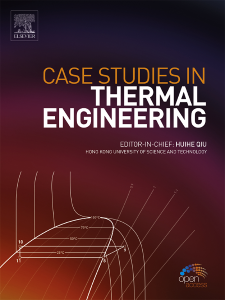Analysis of microstructure of prefabricated fractured granite under thermal effects based on CT technology
IF 6.4
2区 工程技术
Q1 THERMODYNAMICS
引用次数: 0
Abstract
In this study, Computed Tomography (CT) technology was employed to visually analyze the influence of thermal effects on the microstructure of prefabricated fractured granite. The porosity and heterogeneity of the samples were calculated using three-dimensional reconstruction techniques, and two parameters, crack length and orientation, were introduced to quantitatively evaluate the impact of prefabricated fractures on subsequent crack propagation. The results indicated that at 400 °C–500 °C, numerous microcracks were generated within the samples, but they did not interconnect. Above 600 °C, microcracks gradually propagated, forming well-connected crack networks. Due to the uneven thermal stress distribution caused by the prefabricated fractures, samples subjected to temperatures above 600 °C exhibited higher heterogeneity in the vertical direction. While in other directions, the samples gradually tended to homogenize as the temperature rose. Below 500 °C, crack length was significantly affected by the prefabricated fractures, although this influence diminished with increasing distance from the fractures. When the temperature was below 400 °C, microcracks mainly propagated along the direction of the prefabricated fractures. However, when the temperature exceeded 500 °C, microcracks began to initiate and propagate in the opposite direction of the prefabricated fractures, and anti-wing cracks started to emerge.
基于 CT 技术的热效应下预制断裂花岗岩微观结构分析
本研究采用计算机断层扫描(CT)技术,直观分析了热效应对预制断裂花岗岩微观结构的影响。利用三维重建技术计算了样品的孔隙率和异质性,并引入了裂缝长度和走向两个参数,以定量评估预制裂缝对后续裂缝扩展的影响。结果表明,在 400 ℃-500 ℃ 时,样品内部产生了大量微裂纹,但这些裂纹并不相互连接。在 600 °C 以上,微裂纹逐渐扩展,形成了连接良好的裂纹网络。由于预制裂缝造成的热应力分布不均匀,温度高于 600 °C 的样品在垂直方向表现出较高的异质性。而在其他方向,随着温度的升高,样品逐渐趋于均匀化。低于 500 °C时,裂缝长度受预制裂缝的影响很大,但随着与裂缝距离的增加,这种影响逐渐减弱。当温度低于 400 ℃ 时,微裂缝主要沿着预制裂缝的方向扩展。然而,当温度超过 500 ℃ 时,微裂缝开始沿着预制裂缝的相反方向产生和扩展,并开始出现反翼裂缝。
本文章由计算机程序翻译,如有差异,请以英文原文为准。
求助全文
约1分钟内获得全文
求助全文
来源期刊

Case Studies in Thermal Engineering
Chemical Engineering-Fluid Flow and Transfer Processes
CiteScore
8.60
自引率
11.80%
发文量
812
审稿时长
76 days
期刊介绍:
Case Studies in Thermal Engineering provides a forum for the rapid publication of short, structured Case Studies in Thermal Engineering and related Short Communications. It provides an essential compendium of case studies for researchers and practitioners in the field of thermal engineering and others who are interested in aspects of thermal engineering cases that could affect other engineering processes. The journal not only publishes new and novel case studies, but also provides a forum for the publication of high quality descriptions of classic thermal engineering problems. The scope of the journal includes case studies of thermal engineering problems in components, devices and systems using existing experimental and numerical techniques in the areas of mechanical, aerospace, chemical, medical, thermal management for electronics, heat exchangers, regeneration, solar thermal energy, thermal storage, building energy conservation, and power generation. Case studies of thermal problems in other areas will also be considered.
 求助内容:
求助内容: 应助结果提醒方式:
应助结果提醒方式:


